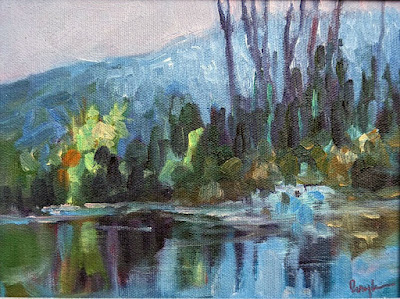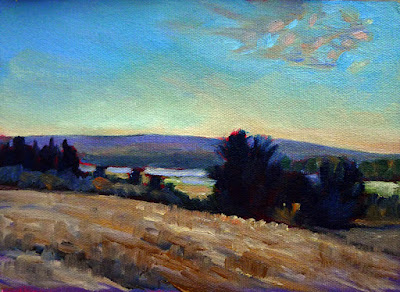The choice is a stark one: either we cut consumption, or we start supporting efforts to bring more green energy into our homes. Which will it be?
 |
| The Alaska Range, oil on canvasboard, 12X16, $1159 unframed. |
I have driven along pipelines many times in my perambulations in the Great White North. I’ve found them interesting and no more intrusive than roads. The ones I saw in Canada were well-maintained. (That may not be true in California, which raises the question of the disconnect between our talk and actions.)
Nevertheless, pipelines are the safest way to move oil and gas in terms of human accident, and they have the lowest carbon footprint. Still, we’ve come to the corporate conclusion that they’re somehow bad.
 |
| Spring greens, 8X10, is one of the paintings that will be at Camden Public Library’s Picker Room this month. |
I really dislike the look of modern windmills. I find big windmill farms intrusive, and I think they muck up the landscape. Luckily, there’s a lot of landscape out there, so I can easily find another ridge, mountain, or butte to paint. They look even more ungainly in the ocean, but there’s almost three times as much ocean as there is land on our planet.
Solar farms aren’t good-looking either, but they don’t stick up as high. One was built over a beautiful blueberry barren in Rockland last spring. I see it every morning when I walk up Beech Hill. At first, it annoyed me. However, one small blueberry barren will hardly be missed in Maine, and when I paint that view, I just leave it out.
 |
| High plains pasture, 9X12, oil on birch, $696 unframed. |
Mainers will vote on Question 1 next week. This seeks to retroactively rescind permits for an energy corridor. I think that ‘no’ is the proper vote, for all the reasons set out in this clearly-reasoned essay by Tom Murley. However, most of my readers are not Mainers.
I mention it because it’s typical of how Americans approach the question of energy and the environment. We’re conflicted. We love clean energy in theory, but only as long as we don’t have to look at it or hear it.
Franklin Roosevelt was an ardent supporter of a hydroelectric project in Passamaquoddy Bay. It foundered on the distribution question, but today it would probably be blocked because of the potential impact on fish and animal populations. Still, it would have generated clean energy using tidal action. Congress yanked funding for it in 1936, but had it been built, Down East’s story would be very different today.
 |
| Spring Birch on Beech Hill, 8X10, is one of the paintings that will be at Camden Public Library’s Picker Room this month. |
Americans are becoming gradually more energy efficient, but that has to be set against our rapidly-increasing population. (We experienced a dip in energy use in 2020, but that was due to COVID.) The bottom line is that we want our cars, our laptops, our televisions, our vacations, our flowers and food from the Southern Hemisphere, our pools and our central heat and air conditioning. We will make concessions to use less energy only when those concessions are not too expensive or inconvenient. Few of us want to go back to carrying water from the well, cutting firewood, or doing subsistence farming.
But while we’re not willing to cut consumption, we seem equally unwilling to tolerate intrusions to make or move energy with alternative technologies. My friend Garrett, a retired oilman, reminded me that fracking was introduced as a clean energy alternative. We oppose pipelines, power corridors, offshore windmills, and other efforts to cut greenhouse emissions because they will personally inconvenience us, or because we have a romanticized notion of the woods and the water.
The choice is a stark one: either we cut consumption, or we start supporting efforts to bring more green energy into our homes. Which will it be?



























